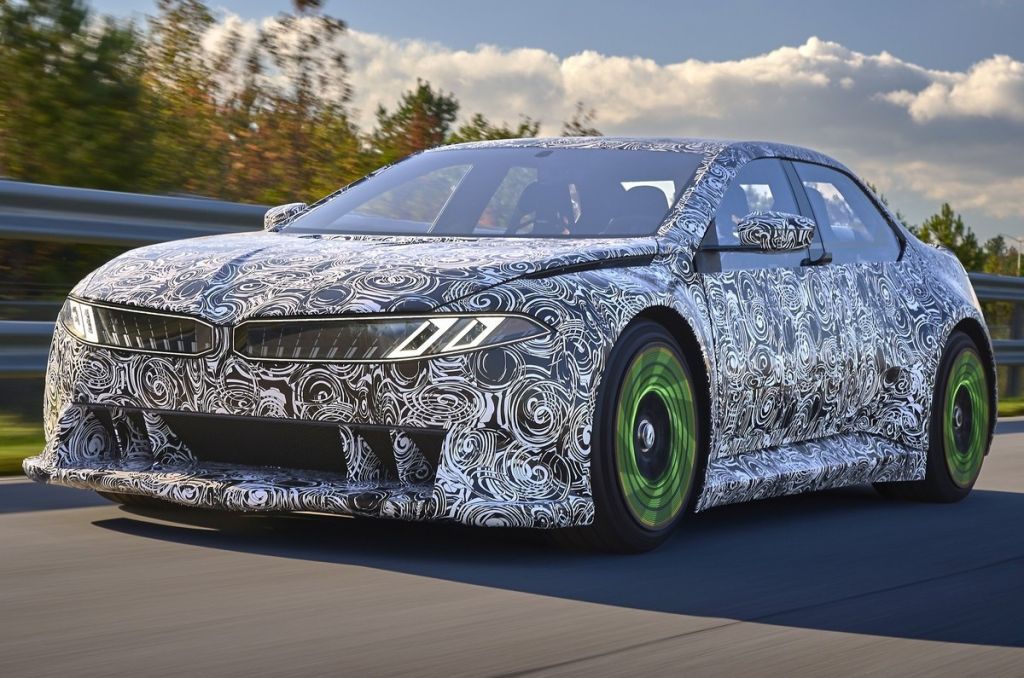
BMW has unveiled a new concept dubbed the Vision Driving Experience that offers a glimpse at some of the intelligent systems that will make their way into the production-spec electric 3 Series (which will likely be christened the i3), the next-gen M3, and the rest of the Neue Klasse line-up. The Vision Driving Experience concept itself is not destined for production, but BMW claims that the technologies it introduces will help retain the carmaker's renowned driving dynamics.
- BMW Vision Driving Experience debuts clever Heart of Joy control unit
- The concept features colour-changing wheels and makes 18,000Nm of torque
- Gets a big rhomboidal infotainment and carbon-fibre bucket seats
BMW Vision Driving Experience concept: new technologies

According to BMW, the Vision Driving Experience concept is a "rolling test rig for drivetrain and driving dynamics management technology." Chief among these new systems is an electronic control unit dubbed the "Heart of Joy," which oversees critical vehicle functions like the drivetrain, braking, charging, regeneration and steering. Working in conjunction with BMW's Dynamic Performance Control software, the Heart of Joy can process information 10 times faster than the company's previous ECUs, with latencies supposedly in the milliseconds.
The Heart of Joy is one of four central units in the concept's electronics architecture and consolidates drivetrain and driving dynamics functions into a singular unit. The integrated braking and energy recuperation control negate the need of using the conventional friction brakes in most scenarios and relying on regeneration instead, which, according to BMW, can increase efficiency by up to 25 percent. Stopping and restarting is also seamless regardless of whether the car is in a certain drive mode, using active cruise control, or employing the Auto Hold function.
BMW says that the Heart of Joy will be found in every electric Neue Klasse model, and that it'll result in greater efficiency, range and a more enjoyable driving experience. Speaking of which, the Vision Driving Experience generates a whopping 18,000Nm of torque. Handling this much torque makes the Heart of Joy capable of easily dealing with "everyday driving" demands, reckons BMW. In addition to the Heart of Joy, future electric BMWs will be equipped with three core "superbrain" systems that will govern automated driving, climate control, vehicle access and interior and exterior lighting.

Speaking of lighting, the Vision Driving Experience concept also features colour-shifting wheels as a demonstration of the Heart of Joy's operation. The wheels glow green when accelerating, blue when recuperating energy, and orange when braking. BMW hasn't detailed how this technology works, but it could be similar to the e-ink mechanism utilised for the colour-changing body panels of the carmaker's i Vision Dee concept.
BMW Vision Driving Experience concept: exterior

While the Vision Driving Experience concept is in test mule camouflage, its overall proportions echo the likes of the Vision Neue Klasse concept and the spy shots of the next-gen 3 Series. However, the Vision Driving Experience differentiates itself with slimmer integrated clusters for the headlights and kidney grilles than the Vision Neue Klasse, as well as an expansive air dam underneath with two vertical slats on either side.
The window area of the Vision Driving Experience looks identical to the Neue Klasse, complete with the distinctive upward kink at the C-pillar. It's the same story with the tail-lamps and rear profile, but the bumper has two large openings.
BMW Vision Driving Experience concept: interior

The cockpit of the Vision Driving Experience concept is dominated by a large, rhomboidal infotainment screen. Behind it, a smaller display stretches nearly across the width of the dashboard and serves as the instrument cluster. The interior is quite sparse otherwise, with a few buttons on the centre console and minimally cushioned carbon-fibre bucket seats.
BMW has confirmed that production of the first Neue Klasse model will commence later this year at the carmaker's plant in Debrecen, Hungary. A global debut of the production-spec electric 3 Series based on the Neue Klasse concept can be expected in 2026.
Also see:
Next-gen BMW M3 to get both ICE and EV powertrains